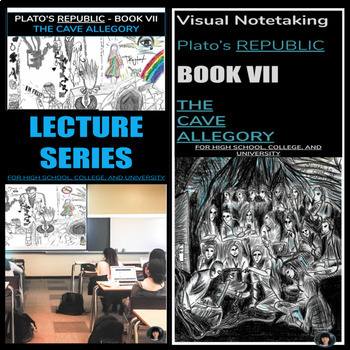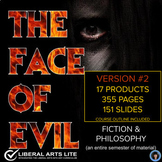CRITICAL THINKING ACTIVITIES (THE CAVE ALLEGORY) | LECTURE & VISUAL ESSAY
- Zip
Products in this Bundle (2)
Also included in
- Embark on a captivating intellectual journey with our semester-long curriculum, "The Face of Evil: Fiction and Philosophy." Delve into the enthralling realm of literature and philosophical thought as you explore the intriguing complexities of evil through various fictional works and profound philosoPrice $37.99Original Price $63.88Save $25.89
- Argumentative text, NIETZSCHE, SOCRATES, ARISTOTLE, argumentative writingJust added Tinker v. Des Moines so page numbers have changedNEW PRODUCTS ADDED SO NOW 1070 PAGES and 464 SLIDESNOW 34 productsAre you looking to inspire intellectual curiosity in your students and teach them the works of some oPrice $75.99Original Price $147.74Save $71.75
Description
CRITICAL THINKING ACTIVITIES (THE CAVE ALLEGORY) | LECTURE & VISUAL ESSAY
❤️❤️ DISCOUNTED BY 20% ❤️❤️
PLATO'S CAVE ALLEGORY
VISUAL NOTETAKING AND LECTURE!
The Cave Allegory is one of the most famous passages of philosophy, and I think all students should study it sometime during their education. It asks its readers to liberate themselves from the conventional bonds that chain them. There are many essays, articles, lecture series, etc. on this fundamental text; there are more nuanced and rigorous academic writings and talks available, but my intention is to provide a 90 minute to two-hour lecture for high school, college, and first or second year university students.
In all of my first year undergraduate classes I employ Visual Notetaking as a way to engage my students in the higher levels of Bloom’s Taxonomy. I always find this assignment rewarding for my students - a helpful way to study, a different type of assignment, a way to engage visual learners, and I am always surprised by their work.
How to get TPT credit to use on future purchases:
• Please go to your My Purchases page (you may need to login). Beside each purchase, you'll see a Provide Feedback button. Simply click it and you will be taken to a page where you can give a quick rating and leave a short comment for the product. I value your feedback greatly as it helps me determine which products are most valuable for your classroom so I can create more for you.
❤️ Click HERE to become a follower. You will now receive customized email updates about this store.
Copyright © jellycat-in-the-snow productions
All rights reserved by author Permission to copy for single classroom use only Electronic distribution limited to single classroom use only
Please remember that any of the products that you download from my store are my copyrighted property and licensed only for you to share with your direct students. If another teacher wants to use these same products, they will need to purchase them directly from my TpT store, or you may purchase an additional license for them. None of my products may be shared online. Posting of my copyrighted materials may happen only in a password-protected environment, such as Google Classroom, and accessed only by your students. Posting on public websites (WordPress, Blogger, Facebook Groups, etc.) is strictly prohibited.







